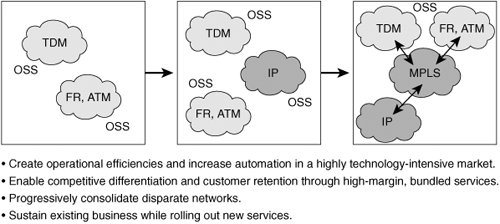Industry Dynamics and Challenges
| Since 1999, service providers have been in the process of evaluating and evolving their multiple networks to a single converged infrastructure upon which they will deploy existing and future services. IP/MPLS is recognized by most service providers as the service-aware technology that facilitates convergence and provides operating efficiencies and service flexibility. Further, IP/MPLS is the foundation for the service provider NGN evolution or network convergence. To be service aware, the architecture should offer a differentiated set of services to client applications. Chapter 10, "Multicast and NGN," explores these service-aware attributes that are part of the differentiated services architecture. Chapter 2, "The Scope of Service Types," focuses on the MPLS technology as an introductory topic to demonstrate the service creation opportunities. However, factors behind the convergence trend in the industry include a reduction of operating expense, optimizing capital expenditure, and generating new services ultimately to retain profitability. Declining revenues, aging infrastructure, increased competition among service providers, and regulatory condition factors designed to open up the market are additional factors behind the adoption of IP/MPLS by many service providers today. For service providers, we note that aging infrastructurefor example, some PSTN switchescan be ten years or older. Consequently, maintaining such infrastructure becomes cost prohibitive over time. An additional critical factor for such service convergence is to decrease the time to market (TTM) for new services, such as IP-based services, and to facilitate the operating expense reduction (OPeX), such as multiple operations support systems (OSS). The mid- to long-term strategy characterized over the next three to seven years is for service providers to consolidate these various networks to an all-packet network that supports both existing revenue streams and future new profitable services. Some service providers have already begun this consolidation process. In the long term, the telecommunications industry can no longer support multiple networks to deploy services as these will become cost prohibitive to maintain because they include numerous OSSs, a variety of network operations centers, and so on. Content, broadband, and mobility are drivers for these new profitable services. An evolutionary strategy means a gradual deployment of new services for top-line growth and new customers that require the lowest-cost network architectures. Therefore, migration to IP/MPLS should facilitate this consolidation and the delivery of common services. Figure 1-1 depicts the evolution toward a multiservice-aware IP/MPLS core and highlights the operational inefficiencies with the multiple OSSs. The figure also identifies the opportunity for service automation that can be possible with a converged network using MPLS. Figure 1-1. Service Provider Network Evolution: Network Consolidation One industry dynamic that is a factor for convergence is the merger and acquisitions of service provider companies, such as SBC-AT&T-BellSouth or BT-Infonet. These mergers and acquisitions only highlight the competitive nature of the service market and the trend toward SP industry consolidation. As mentioned previously, this convergence trend toward a packet-based network, namely IP/MPLS, has often been called the next-generation network, a term depicting the evolution from a circuit-switched paradigm to IP/MPLS. The International Telecommunications Union (ITU) has defined the NGN in ITU-T Recommendation Y.2001 as follows:
NGNs within service provider companies are also characterized by such factors as:
Architecturally, convergence can be depicted by layer simplification, such as IP directly to optics. In fact, converged architectures are no longer a futuristic goal but rather an active pursuit for service providers, such as the following examples: British Telecom's twenty-first century initiative (http://www.btglobalservices.com/business/global/en/business/business_innovations/issue_02century_network.html) and Telecom Italia (http://www.borsaitalia.it/media/borsa/db/pdf/new/2385.pdf). |
EAN: 2147483647
Pages: 162